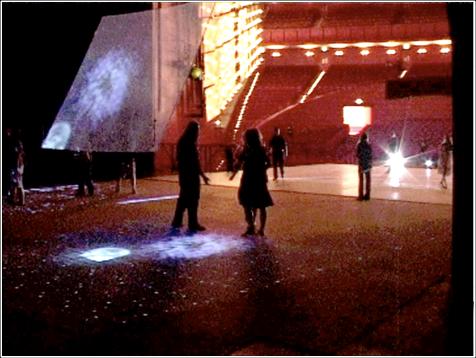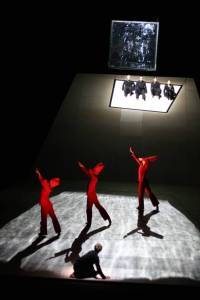Galileo in Hell was developed in collaboration with Aldes company, reworked by modifying its original interactive story (shown first at Nurberg, July 2006). The show took place in Milan at the Arcimboldi Theatre.
A video is available here.
It was a great audience success and a rewarded experience for the authors, demonstrating how CALLAS can improve both the work of creative industries and the artistic experience fruition.


The audience on the stage at Galileo in Hell, interacting with Galaxies and Star's Shadows.
The life of the Italian scientist Galileo Galilei (1564-1642) is emblematic of the complex relationship between scientific research and religious faith, between freedom of thought and cultural conventions, between technological invention and the development of consciousness. 

The audience on the stage at Galileo in Hell, interacting with Galaxies and Star's Shadows.
In the very profound thinking of this founder of the scientific method and of modern science, there is a surprising and little known attempt to marry mathematical precision with poetic and artistic imagery.
In fact in the two lessons held at the Florentine Academy, location and size of Dante's Inferno of 1588, Galilei retraces step by step Dante’s voyage through hell trying, based on the “divine†verses and as a commentary to the two opposing theories of the Florentine mathematicians of the time, to provide a rational explanation, both mathematical and geometric, of the infernal circles and the demons that inhabit them, calculating measurements and proportions of the places, of the giants and finally of Lucifer himself.
Here Galileo ideally (and paradoxically) applies his scientific method and his mathematical calculations to the “infernal theatre†of which Dante was the “architect and choreographerâ€. And out of this, out of this interweaving of art and science, the show takes its inspiration to embark on a symbolic voyage using the contemporary languages of dance and interactive images.
 The use of interactive devices allows the dancers to transform the set in real time with their movements, overcoming the traditional separation between body and set, and connecting profoundly with Galileo’s principle of a technology that can go beyond the perceptive scope of man, and go so far as to measure a “fantastic†and purely imaginary place such as Dante’s inferno. The show is therefore not a biographic portrait, but a visionary itinerary made by Galileo to Hell, out of which he was brought with the “ movements of bodies†choreographed by Daniela Kurz, with the mutating and interactive projections by Studio Azzurro, with speech fragments elaborated by Andrea Balzola from Galileo’s writings and documents, all set to music by Tommaso Leddi.
The use of interactive devices allows the dancers to transform the set in real time with their movements, overcoming the traditional separation between body and set, and connecting profoundly with Galileo’s principle of a technology that can go beyond the perceptive scope of man, and go so far as to measure a “fantastic†and purely imaginary place such as Dante’s inferno. The show is therefore not a biographic portrait, but a visionary itinerary made by Galileo to Hell, out of which he was brought with the “ movements of bodies†choreographed by Daniela Kurz, with the mutating and interactive projections by Studio Azzurro, with speech fragments elaborated by Andrea Balzola from Galileo’s writings and documents, all set to music by Tommaso Leddi. The set is conceived as a metamorphic organism where, shifting progressively between macrocosm and microcosm, with the dancers bodies seen as emanations of Galileo’s thoughts as they interact with the video-projections, producing a form of “anthropomorphic cosmogonyâ€.







